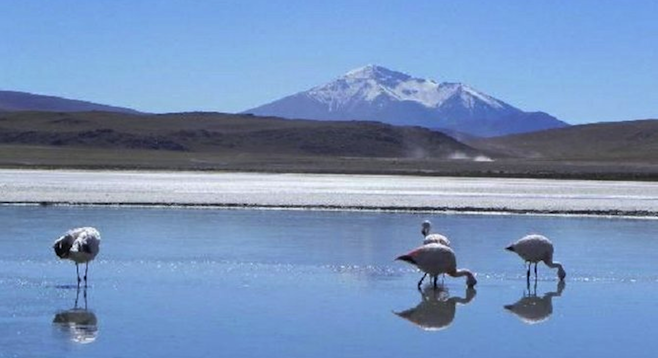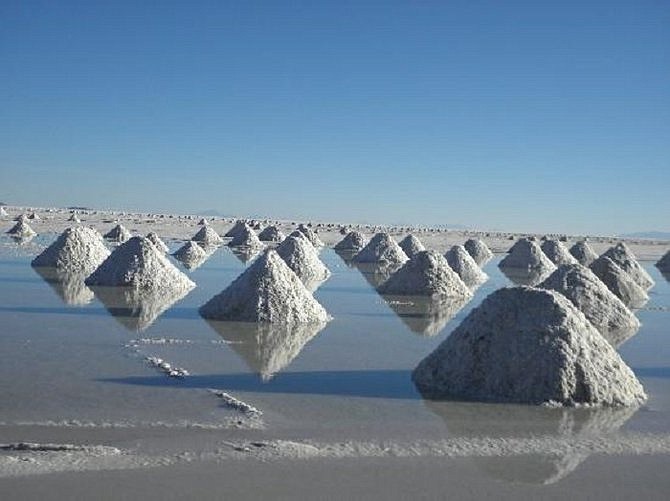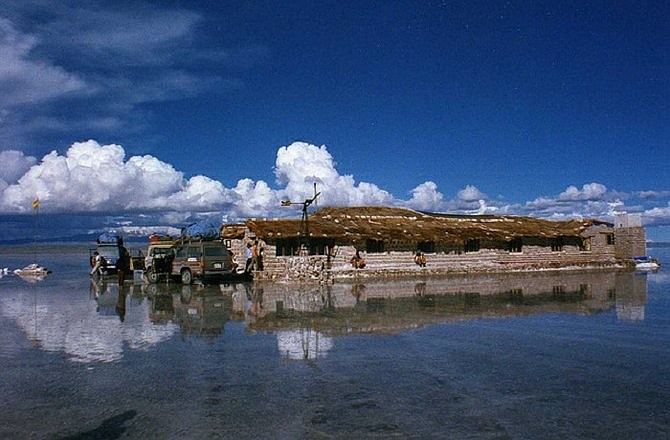 Facebook
Facebook
 X
X
 Instagram
Instagram
 TikTok
TikTok
 Youtube
Youtube

The landlocked (and usually overlooked) country of Bolivia in South America is home to the largest salt flats in the world, visible by astronauts in space.

The Salar de Uyuni is 25 times larger than Utah’s Bonneville Salt Flats at 12,000 square kilometers and comprises most of the Bolivian altiplano. It would be an ideal location for a Star Wars movie if it weren’t 3,600 meters above sea level with some areas at 5100 meters creating migraines and altitude sickness.
All travelers experience the typical Bolivian bus ride from the capital of La Paz with 13 hours of rattling and shaking across rugged and often inhospitable terrain with below-zero temperatures. Once you arrive you’ll feel as though you’ve been through a vibrating gym workout with ice-cold feet. On the bright side, there are plenty of photo opportunities along the way with wildlife such as birds, llamas, flamingoes (top) and plenty of cute chinchillas. Many travelers visit Bolivia just to experience this region.
I had read that the town of Uyuni was an unattractive place full of trash with little to keep you there; as we approached the settlements there were hundreds of plastic bags in the bushes and everywhere we saw wrecked cars resembling a war-torn place. The center of the city is full of unpaved roads and overpriced internet cafes, souvenirs and restaurants. The city is a bit dead, and the only real attraction is an old train graveyard full of rusty old trains littered with trash.

Once I arrived and had a breakfast of cold eggs and stale bread, I was ready to head out for a road trip through the outback and get out of Uyuni. Most accommodations in the area are made of either mud or salt (and very basic) with little insulation. Heat and hot water are not amenities; even the walls, beds and furniture are made of salt.
Tour operators in Uyuni all offer the same thing at the same price so trust your gut feeling when it comes to choosing a trip. Make sure there are a maximum of six people in a vehicle, as fatal accidents have occurred in the past when people were crammed into vehicles. Don’t make the mistake I did and pay for “first-class” seating – all seats are the same, and complaining gets you nowhere in Bolivia. The customer is definitely not king here. Check on border crossing fees before you arrive so you're not charged with illegal fees.
Some of the realities of Uyuni tours include questionable food, accommodations with no running water in ice-cold rooms, infrequent electricity and no internet service, radio or TV. You might eat at a restaurant in near total darkness depending on electrical service.

The Salar de Uyuni Hotel (left) is one of the most popular attractions with travelers around the world. Constructed entirely of salt blocks and resembling an igloo, this charming hotel is one of the very few hotels with working fireplaces, electric heat and cozy bedding. And the food was decent for Bolivian standards.

At the opposite end of luxury is the Hostal Marith, a quiet no-nonsense backpackers’ favorite. You won’t find consistent service (or regular hot water or heat) here. Lonely Planet recommends this place for the budget traveler, but many traveler reviews don’t share this recommendation.
The best accommodations fill up fast, so reservations are recommended especially if coming into Uyuni late at night. Only the more expensive hotels have heat and hot water, so a sleeping bag and waterless shampoo and body wash are recommended. There is water rationing here year-round.
The best months to visit are April, May, September, October and November, when there’s plenty of sun and less chance of rain or snow.


The landlocked (and usually overlooked) country of Bolivia in South America is home to the largest salt flats in the world, visible by astronauts in space.

The Salar de Uyuni is 25 times larger than Utah’s Bonneville Salt Flats at 12,000 square kilometers and comprises most of the Bolivian altiplano. It would be an ideal location for a Star Wars movie if it weren’t 3,600 meters above sea level with some areas at 5100 meters creating migraines and altitude sickness.
All travelers experience the typical Bolivian bus ride from the capital of La Paz with 13 hours of rattling and shaking across rugged and often inhospitable terrain with below-zero temperatures. Once you arrive you’ll feel as though you’ve been through a vibrating gym workout with ice-cold feet. On the bright side, there are plenty of photo opportunities along the way with wildlife such as birds, llamas, flamingoes (top) and plenty of cute chinchillas. Many travelers visit Bolivia just to experience this region.
I had read that the town of Uyuni was an unattractive place full of trash with little to keep you there; as we approached the settlements there were hundreds of plastic bags in the bushes and everywhere we saw wrecked cars resembling a war-torn place. The center of the city is full of unpaved roads and overpriced internet cafes, souvenirs and restaurants. The city is a bit dead, and the only real attraction is an old train graveyard full of rusty old trains littered with trash.

Once I arrived and had a breakfast of cold eggs and stale bread, I was ready to head out for a road trip through the outback and get out of Uyuni. Most accommodations in the area are made of either mud or salt (and very basic) with little insulation. Heat and hot water are not amenities; even the walls, beds and furniture are made of salt.
Tour operators in Uyuni all offer the same thing at the same price so trust your gut feeling when it comes to choosing a trip. Make sure there are a maximum of six people in a vehicle, as fatal accidents have occurred in the past when people were crammed into vehicles. Don’t make the mistake I did and pay for “first-class” seating – all seats are the same, and complaining gets you nowhere in Bolivia. The customer is definitely not king here. Check on border crossing fees before you arrive so you're not charged with illegal fees.
Some of the realities of Uyuni tours include questionable food, accommodations with no running water in ice-cold rooms, infrequent electricity and no internet service, radio or TV. You might eat at a restaurant in near total darkness depending on electrical service.

The Salar de Uyuni Hotel (left) is one of the most popular attractions with travelers around the world. Constructed entirely of salt blocks and resembling an igloo, this charming hotel is one of the very few hotels with working fireplaces, electric heat and cozy bedding. And the food was decent for Bolivian standards.

At the opposite end of luxury is the Hostal Marith, a quiet no-nonsense backpackers’ favorite. You won’t find consistent service (or regular hot water or heat) here. Lonely Planet recommends this place for the budget traveler, but many traveler reviews don’t share this recommendation.
The best accommodations fill up fast, so reservations are recommended especially if coming into Uyuni late at night. Only the more expensive hotels have heat and hot water, so a sleeping bag and waterless shampoo and body wash are recommended. There is water rationing here year-round.
The best months to visit are April, May, September, October and November, when there’s plenty of sun and less chance of rain or snow.
Comments